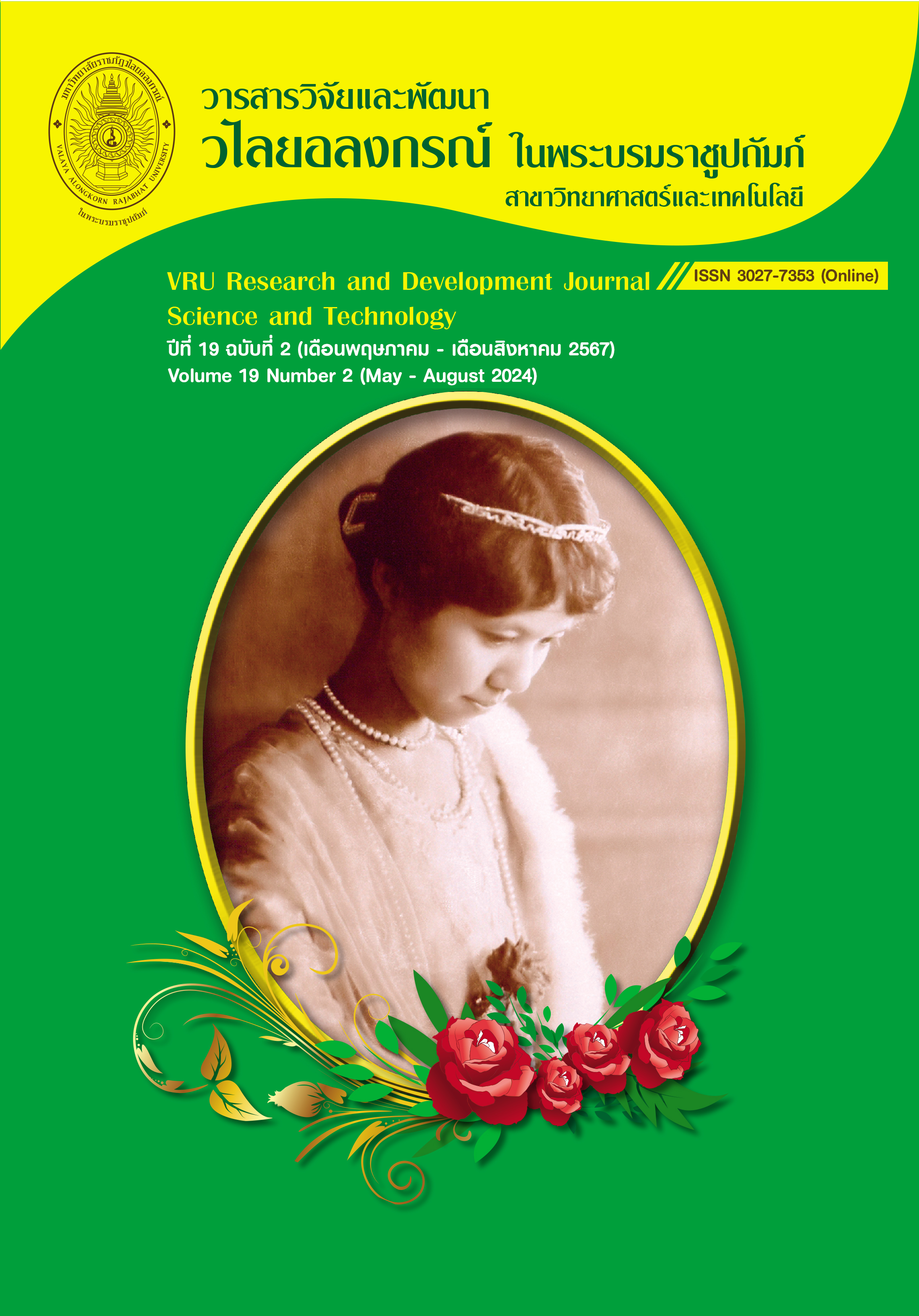TOTAL PHENOLIC CONTENTS AND ANTIOXIDANT ACTIVITIES OF THE EXTRACT OF TRI-CHATIKA PHARMACOPOEIA
Main Article Content
Abstract
The Tri-Chatika formula contains three types of herbs: cinnamon bark (Cinnamomum verum J. Presl.), cardamom seeds (Amomum testaceum Ridl.), and mace (Myristica fragrans Houtt) in a 1:1:1 ratio. The Tri-Chatika formula possesses properties to relieve dyspepsia, flatulence, clear excess phlegm, reduce fever, nourish the mind, relieve uterine pain, and promote a well-balanced body composition of the four elements. The objective of this research was to investigate the total phenolic and antioxidant capacity of the Tri-Chatika pharmacopoeia using four extract solvents: water, 50% ethanolic, 80% ethanolic, and 95% ethanolic. The extracts were analyzed for antioxidant activities using the 2,2-diphenyl-1-picrylhydrazyl (DPPH) and Ferric Reducing Antioxidant Power (FRAP) assays, and the total phenolic contents were determined using the Folin-Ciocalteu assay. The results showed that the 95% ethanolic extract of the Tri-Chatika formula exhibited the highest antioxidant activities in the DPPH assay (EC50 = 10.72±0.20 µg/ml), with differences observed compared to the ethanolic extract and standard ascorbic acid (p< 0.05). The Tri-Chatika formula also exhibited the highest antioxidant activities in the FRAP assay (1.79±0.05 mM Fe2+ equivalent/g extract), with differences observed among the ethanolic extract, standard ascorbic acid, and α-Tocopherol (p< 0.05). Upon investigating the total phenolic contents of the Tri-Chatika formula, it was found that the phenolic content was 2.62±0.32 mg gallic acid equivalent/g extract when extracted with water.
Downloads
Article Details
ลิขสิทธิ์บทความวิจัยที่ได้รับการตีพิมพ์เผยแพร่ในวารสารวิจัยและพัฒนา วไลยอลงกรณ์ ในพระบรมราชูปถัมภ์ ถือเป็นกรรมสิทธิ์ของสถาบันวิจัยและพัฒนา มหาวิทยาลัยราชภัฏวไลยอลงกรณ์ ในพระบรมราชูปถัมภ์ ห้ามนำข้อความทั้งหมดหรือบางส่วนไปพิมพ์ซ้ำ เว้นแต่จะได้รับอนุญาตจากมหาวิทยาลัยเป็นลายลักษณ์อักษร
ความรับผิดชอบ เนื้อหาต้นฉบับที่ปรากฏในวารสารวิจัยและพัฒนา วไลยอลงกรณ์ ในพระบรมราชูปถัมภ์ เป็นความรับผิดชอบของผู้นิพนธ์บทความหรือผู้เขียนเอง ทั้งนี้ไม่รวมความผิดพลาดอันเกิดจากเทคนิคการพิมพ์
References
กรมพัฒนาการแพทย์แผนไทยและแพทย์ทางเลือก กระทรวงสาธารณสุข. (2559). แผนแม่บทแห่งชาติว่าด้วยการพัฒนาสมุนไพรไทย ฉบับที่ 1 พ.ศ.2560–2564. ทีเอส อินเตอร์พริ้นท:กรุงเทพมหานคร.
จักรรินทร์ ศรีวิไล, และพิพรรธพงศ์ จบมะรุม. (2551). รายงานการวิจัยเรื่อง การศึกษาชนิดของตัวทำละลายที่ใช้ในการสกัดและทดสอบฤทธิ์ต้านอนุมูลอิสระจากผลมะแขว่น (Zanthoxylum limonella (Dennst) Alston). พิษณุโลก: มหาวิทยาลัยนเรศวร.
จาตุรงค์ จงจีน. (2557). รายงานการวิจัยเรื่อง ผลของสารสกัดจากสาบเสือต่อการ เจริญของเชื้อรา Pyricularia grisea Sacc. สาเหตุโรคใบไหม้ของข้าว. อุบลราชธานี: มหาวิทยาลัยราชภัฏ อุบลราชธานี.
จิราภรณ์ บุราคร, และเรือนแก้ว ประพฤติ. (2555). ผลของสารสกัดสมุนไพรพื้นบ้านไทย จำนวน 7 ชนิดต่อการยับยั้งเชื้อแบคทีเรีย. วารสารการแพทย์แผนไทยและการแพทย์ทางเลือก, 10, 11-22.
นพมาศ สุนทรเจริญนนท์, และนงลักษณ์ เรืองวิเศษ. (2551). วิเคราะห์ วิจัย คุณภาพเครื่องยาไทย.
คอนเซ็พท์ เมดิคัส จำกัด: กรุงเทพมหานคร.
พัชรินทร์ บุญหล้า, เมธิน ผดุงกิจ, อุดมศักดิ์ มหาวีรวัฒน์, และธิดารัตน์ สมดี. (2557). ฤทธิ์ต้านออกซิเดชัน และฤทธิ์ต้านการก่อกลายพันธุ์ของสารสกัดใบชะพลู. วารสารเภสัชศาสตร์อีสาน, 10(3), 283–294.
มูลนิธิฟื้นฟูส่งเสริมการแพทย์ไทยเดิมฯ อายุรเวทวิทยาลัย (ชีวกโกมารภัจจ์). (2548). ตำราเภสัชกรรมไทย.
ed. กรุงเทพฯ: พิฆเณศ พริ้นติ้ง เซ็นเตอร์.
รัฐศาสตร์ เด่นชัย, ณลิตา ไพบูลย์, นพวรรณ์ พรศิริ, และสุรพงศ์ รัตนะ. (2564). ฤทธิ์การต้านอนุมูลอิสระ สารฟีนอลิก และฟลาโวนอยด์ทั้งหมดในสารสกัดมะหวด (Lepisanthes rubiginosa). วารสารวิทยาศาสตร์ คชสาส์น, 43(2), 1-9.
รัตนา อินทรานุปกรณ์. (2547). การตรวจสอบและการสกัดแยกสารสำคัญจากสมุนไพร. กรุงเทพมหานคร:สำนักพิมพ์แห่ง จุฬาลงกรณ์มหาวิทยาลัย.
สำนักงานราชบัณฑิตยสภา กรมการแพทย์แผนไทยและการแพทย์ทางเลือก กระทรวงสาธารณสุข. (2559). พจนานุกรมศัพท์แพทย์และเภสัชกรรมไทย ฉบับราชบัณฑิตยสถาน พ.ศ.2559. กรุงเทพฯ : ราชบัณฑิตยสถาน.
โอภา วัชระคุปต์. (2550). สารต้านอนุมูลอิสระ = Radical scavenging agents. พิมพ์ครั้งที่ 2. กรุงเทพฯ: พิมพลักษณ์.
อรพิน เกิดชูชื่น, ณัฏฐา เลาหกุลจิตต์, และมณฑกาญจน์ ชนะภัย. (2553). คุณลักษณะสารสกัดจากพืชวงศ์ Apiaceae และ Piperaceae จำนวน 4 ชนิด. วารสารวิจัยมหาวิทยาลัยราชภัฏสวนดุสิต, 3, 35-44.
Benzie, I. F. F., & Strain, J.J. (1996). The Feric Reducing Abillity of Plasma (FRAP) as a Measure of “Antioxidant Power”: The FRAP Assay. Analytical Biochemistry, 239(1), 70-76. https://doi.org/10.1006/abio.1996.0292.
Gong, Y., Liu, X., He, W. -H., Xu, H. -G., Yuan, F., & Gao, Y. -X. (2012). Investigation into the antioxidant activity and chemical composition of alcoholic extracts from defatted marigold (Tagetes erecta L.) residue. Fitoterapia, 83(3), 481-489. https://doi.org/
1016/j.fitote.2011.12.013.
Gomes de Melo, J., De Sousa Araújo, T. A., Thijan Nobre de Almeida e Castro, V., Lyra de Vasconcelos Cabral, D., Do Desterro Rodrigues, M., Carneiro do Nascimento, S., Cavalcanti de Amorim, E. L., et al. (2010). Antiproliferative activity, antioxidant capacity and tannin content in plants of Semi-Arid Northeastern Brazil. Molecules, 15(12), 8534–8542. http://dx.doi.org/10.3390/molecules15128534.
Kim J. S. (2013). Preliminary evaluation for comparative antioxidant activity in the water and ethanol extracts of dried citrus fruit (Citrus unshiu) peel using chemical and biochemical in Vitro assays. Food and Nutrition Sciences, 4(2), 177-188.
Saeed, M., Erwa, I., Ahmed, H., Ramadhani, A., & Ishag, O. (2020). Phytochemical Screening, Chemical Composition and Antimicrobial Activity of Cinnamon verum Bark. International Research Journal of Pure and Applied Chemistry, 21, 36-43.
Sindhe, M. A., Yadav, D. B., & Chandrashekar A. (2013). Antioxidant and In Vivo anti-hyperglycemic activity of Muntingia calabura leaves extracts. Der Pharmacia Lettre, 5, 427-435.

